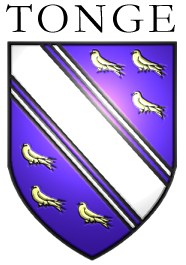
| Home - Back to main page | |
| Index - Full contents list including primary and secondary source documents | |
| Genealogies - Several different Tonge family histories contributed by other researchers | |
| Search Site |
p4 Tong Conservation Area
Tong Conservation Area was originally designated in 1973. The designation covers virtually the entire village which extends in a linear fashion along Tong Lane, the main thoroughfare. Tong village predates the Norman Conquest and was the seat of Tong Manor between the thirteenth and mid-twentieth centuries. The manor remained in the hands of the Tempests, who resisted the expansion and industrialisation of the village, for some four hundred years before selling the Hall and estate in 1941. Unusually, a great number of the buildings in the conservation area were built in the eighteenth century including Tong Hall (1702) and the adjacent courtyard (1711), St James’s Church (1727), the school (1736) and several newly built and rebuilt farmhouses and estate cottages. These buildings used a mixture of red brick and local gritstone, making the conservation area unique in Bradford in terms of materials. The survival of these buildings and key open spaces such as Tong Park, the churchyard and cricket ground and the original pastoral setting makes Tong a very pleasant and rare rural estate village in West Yorkshire.
p5 Location
Tong is in the extreme southeast of Bradford District in a green wedge of land between the urban areas of Bradford and Leeds, the centre of the former being 5km to the northwest and the centre of the latter being about 6km to the northeast. Although surrounded by Green Belt, most of the settlements nearest to Tong are urban in character, Tong Street being 2.5km to the west of the village, Drighlington 1.5km to the south, Gildersome, 2.5 km to the southeast and New Farnley 2km to the east. The rural village of Bankhouse and the Moravian settlement of Fulneck are about 1km to the north of Tong with Cockersdale 1km to the southeast.
p7-8 Origin and History
Although there is little evidence of any permanent settlement of the area from prehistoric to through Roman times, St James Church provides conclusive evidence of a settlement of some importance at Tong in Saxon times. Excavations undertaken during the restoration of the church in the 1970s uncovered the fragmentary walls and foundation stones of two earlier buildings contained within the footprint of the remains of a Norman-era church which was built circa 1140. The rare discovery of grave markers within these two buildings alludes to the fact that a church existed on the site of the present day church from the eleventh century, and, moreover, prior to the Norman invasion of 1066. St James Church is the only identifiable pre-Conquest church in West Yorkshire and is therefore of considerable historic interest. Around the time of the Norman invasion, it is known that Tong Manor was farmed and was owned by a Saxon named Stainulf. As happened across the country after 1066, the Norman invaders knocked down existing churches and built a new place of worship, often on the site of the church they demolished, and, under William the Conqueror, high ranking Normans were installed as the new lords and overlords of the English manors. By the time of the Domesday Survey, in 1086, some twenty years after the invasion, Tong Manor was held by Ilbert de Lacy, an ally of William Conqueror, who is recorded in the survey as holding 162 manors. Among de Lacy’s holdings was all of what is now Bradford (excluding Eccleshill). At the time of the Domesday survey all manors which were held directly by de Lacy lay undeveloped wasteland, including the 2000 acre Tong Manor, although it is known that Tong was cultivated when in the possession of Stainulf.
Asolf, an extensive landowner in West Riding, appears to have been lord of Tong Manor from around 1135 to about 1159 and it is therefore probably he who rebuilt the church in about 1140 on the site of the demolished pre-Conquest church. Asolf had many sons, who, instead of taking the name Fitzasolf (son of Asolf) were named after where they were made lord of the manor on their father’s death. In this way, Asolf’s son Richard de Tang (c.1130-c.1195) was the first in a line of Lords of Tong who would inhabit Tong Hall and oversee the running of the manor until 1941. The name Tong comes from the Old English term tang meaning tong or fork and refers to the village’s position on a raised sliver of land between Ringshaw Beck and Cockersdale which converge at the eastern extreme of the manor. Tong remained in the possession of the de Tangs as an agricultural manor for nine generations until the death of Hugh de Tong in 1445 and the passing of the manor to his grandson, John Mirfield.
p50 Further reading
Bartle & Son (Auctioneers) (1943) The Tong Hall
Estate: Particulars, Plans and Conditions of Sale
Cudworth, W (1876) Round About Bradford
Mountain Press, Queensbury, 1968
Cudworth, W (1876?) Fulneck and Tong: Historical
Account and Description
Flohill, R (1956) Portrait of a Village: Tranquility of
Tong
Yorkshire Observer Budget
Grove, LRA (1940) Two Local Sundials
Ernest Cummins, Bradford
Hey, D (1981) Buildings of Britain: Yorkshire
Moorland Publishing
Kitchen, Rev A & Swann, A Whitworth, A (ed.)
(1979) A Thousand Years in Tong: The History and
Archaeology of the Church of St James and the
Interior Restoration of 1979
MacDonald, AS (2002) Tong Hall, Tong, Bradford:
A History and Description of the Manor and Hall at
Tong in its Tercentenary Year
Parker, J (1904) Illustrated Rambles from
Hipperholme to Tong
Percy Lund, Humphries & Co, London
Robertshaw, W (1954) The Manor of Tong
Robertshaw, W (1960) The Church of St James,
Tong
Robinson, L (1985) The Tong Manuscripts
The Bradford Antiquary 3rd Series Number 1
Virdee, SP (1986) Tong: A Provisional Survey
Department of Ancient History and Archaeology,
University of Birmingham